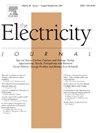Accelerating room air conditioner efficiency in India: Grid, economic, and policy implications through 2035
IF 2.2
Q1 Social Sciences
引用次数: 0
Abstract
India is poised for a rapid surge in space cooling demand, driven by rising incomes, urbanization, and intensifying heat. Between 2025 and 2035, the country is expected to add 130–150 million new room air conditioners (ACs). If Minimum Energy Performance Standards (MEPS) continue to improve at the historical rate of 2–3 % annually, room ACs alone could contribute over 180 GW to peak electricity demand by 2035-nearly 30 % of the projected national total. This study evaluates the impact of an accelerated MEPS trajectory, proposing to raise the 1-star threshold to ISEER 5.0 by 2027, ISEER 6.3 by 2030, and ISEER 7.4 by 2033. Drawing on engineering cost analysis, stock turnover modeling, and retail pricing data, we find that this pathway could reduce peak demand by over 60 GW, save 118 TWh of electricity annually, avoid 49 MtCO₂ of electricity-related emissions per year, avert ₹7.5 trillion (∼US$85 billion) in power system investments, and yield ₹0.7–2.3 trillion (∼US$8–26 billion) in net consumer savings by 2035. Contrary to affordability concerns, empirical trends show that higher efficiency does not increase AC prices. These results highlight the value of ambitious MEPS as a cost-effective strategy for improving grid reliability, reducing emissions, and advancing consumer welfare in emerging economies.
加速印度室内空调效率:到2035年的电网、经济和政策影响
在收入增长、城市化和高温加剧的推动下,印度即将迎来空间降温需求的快速增长。2025年至2035年间,中国预计将新增1.3亿至1.5亿台空调。如果最低能源性能标准(MEPS)继续以每年2-3 %的历史速度提高,到2035年,仅室内空调就可以为峰值电力需求贡献超过180 GW的电力需求,接近全国预计总量的30% %。本研究评估了加速MEPS轨迹的影响,提出到2027年将1星阈值提高到ISEER 5.0,到2030年提高到ISEER 6.3,到2033年提高到ISEER 7.4。根据工程成本分析、库存周转模型和零售定价数据,我们发现这条路径可以减少峰值需求超过60 GW,每年节省118 太瓦时的电力,每年避免4900万二氧化碳的电力相关排放,避免7.5万亿卢比(约850亿美元)的电力系统投资,并在2035年之前产生0.7-2.3万亿卢比(约80 - 260亿美元)的净消费者储蓄。与负担能力问题相反,经验趋势表明,更高的效率并不会增加空调价格。这些结果突出了雄心勃勃的MEPS作为提高电网可靠性、减少排放和提高新兴经济体消费者福利的成本效益战略的价值。
本文章由计算机程序翻译,如有差异,请以英文原文为准。
求助全文
约1分钟内获得全文
求助全文
来源期刊

Electricity Journal
Business, Management and Accounting-Business and International Management
CiteScore
5.80
自引率
0.00%
发文量
95
审稿时长
31 days
期刊介绍:
The Electricity Journal is the leading journal in electric power policy. The journal deals primarily with fuel diversity and the energy mix needed for optimal energy market performance, and therefore covers the full spectrum of energy, from coal, nuclear, natural gas and oil, to renewable energy sources including hydro, solar, geothermal and wind power. Recently, the journal has been publishing in emerging areas including energy storage, microgrid strategies, dynamic pricing, cyber security, climate change, cap and trade, distributed generation, net metering, transmission and generation market dynamics. The Electricity Journal aims to bring together the most thoughtful and influential thinkers globally from across industry, practitioners, government, policymakers and academia. The Editorial Advisory Board is comprised of electric industry thought leaders who have served as regulators, consultants, litigators, and market advocates. Their collective experience helps ensure that the most relevant and thought-provoking issues are presented to our readers, and helps navigate the emerging shape and design of the electricity/energy industry.
 求助内容:
求助内容: 应助结果提醒方式:
应助结果提醒方式:


